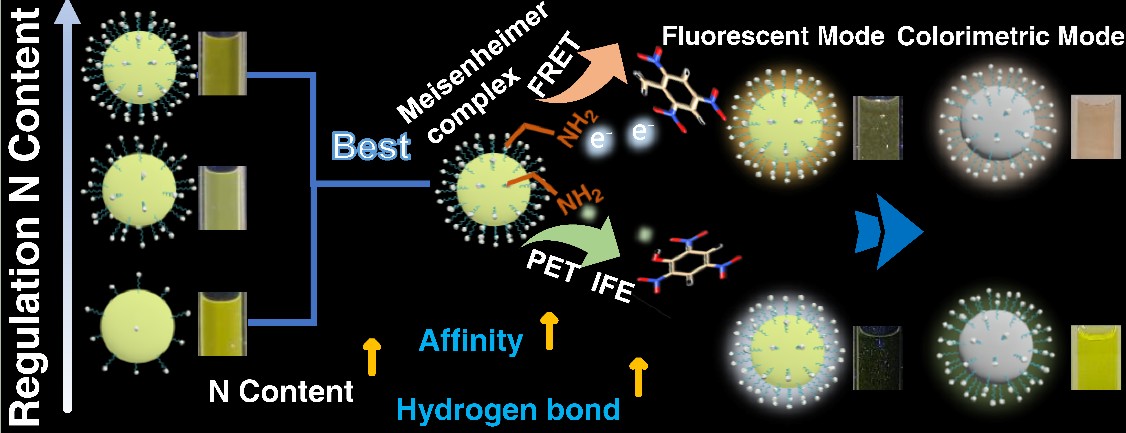A Design Strategy of Carbonized Polymer Dots for Discrimination of TNT and TNP
Editor: | Apr 22,2025
2,4,6-Trinitrotoluene (TNT) and 2,4,6-trinitrophenol (TNP) are typical representatives of explosives, which are resistant to rapid decomposition due to their stable physical and chemical properties. Consequently, their long-term accumulation can lead to pollution of terrestrial and aquatic ecosystems, adversely affecting the environment and human health. Thus, the highly sensitive, rapid and on-site identification of trace TNT and TNP is of great significance for environmental and safety requirements. It is known that TNT and TNP sensing is generally based on energy transfer or electron transfer to generate a fluorescence turn-off response, however, most of these design strategies focus on the properties of the sensing materials towards either TNT or TNP, and there still lacks a systematic investigation on how the modulation of the structure of the sensing materials affects the discrimination of them. Therefore, whether a new functionalized carbonized polymer dots (CPDs) design strategy with high sensitivity, rapid and trace detection towards TNT and TNP could be proposed based on the efficient employment of the recognition site remains a great challenge, but is of vital significance for developing a reliable sensing method for discrimination them from their analogues.
To address this challenge, a research team led by Prof. DOU Xincun from the Xinjiang Technical Institute of Physics and Chemistry of the Chinese Academy of Sciences (CAS) has developed a design strategy of carbonized polymer dots for discrimination of TNT and TNP. Their findings, published in Journal of Hazardous Materials, emphasize tuning the surface environments of -NH2 to improve the reactivity and effective collision with target substance of CPDs with nitroaromatic hydrocarbon explosives.
In this work, researchers based on the strong electron-deficient properties of TNT and TNP, three o-phenylenediamine/polyethyleneimine CPDs (OPD/PEI CPDs) with different densities and types of -NH2 groups on the surface, including aliphatic amines and aromatic amines, were prepared by modulating the mass ratio of the precursors (OPD/PEI are 1, 2, 3). It was shown that the increase of the content of the aliphatic -NH2 groups belonging to PEI on the surface of OPD/PEI CPDs could improve the affinity with TNT and TNP, thereby improving the detection performance. The surface -NH2 group of OPD/PEI CPDs could form a Meisenheimer complex with TNT, triggering the Forster resonance energy transfer process, while forming hydrogen bonds with hydroxyl in TNP, triggering the charge transfer as well as spectral overlap to produce photoinduced electron transfer accompanied with inner filter effect. When the ratio of OPD to PEI is 1:1 and the surface -NH2 content is 26.06%, the OPD/PEI CPDs exhibited a more superior sensing performance toward TNT and TNP, including a low limit of detection (LOD, TNT: 324 nM and 255 µM, TNP: 21.08 nM and 318.6 nM), a rapid response (<1 s), and a rather good specificity even in the presence of 20 kinds of interferents. Moreover, the practicality of the OPD/PEI CPDs was further verified by an OPD/PEI CPDs-based paper sensor, which is capable of discriminating TNT and TNP particles and vapors as low as pg-level and ppm-level, respectively. We expect that the present OPD/PEI CPDs design strategy could provide new ideas for the discrimination of trace analytes with similar structures or properties.

Figure: Schematic illustration of the designed strategy of OPD/PEI CPDs and the colorimetric-fluorescent dual-mode detection of TNT and TNP. (Image by the research team)
附件下载:
 (86) 991-3838931
(86) 991-3838931 lhskj@ms.xjb.ac.cn
lhskj@ms.xjb.ac.cn (86)991-3838957
(86)991-3838957 40-1 Beijing Road
Urumqi, XinjiangChina
40-1 Beijing Road
Urumqi, XinjiangChina